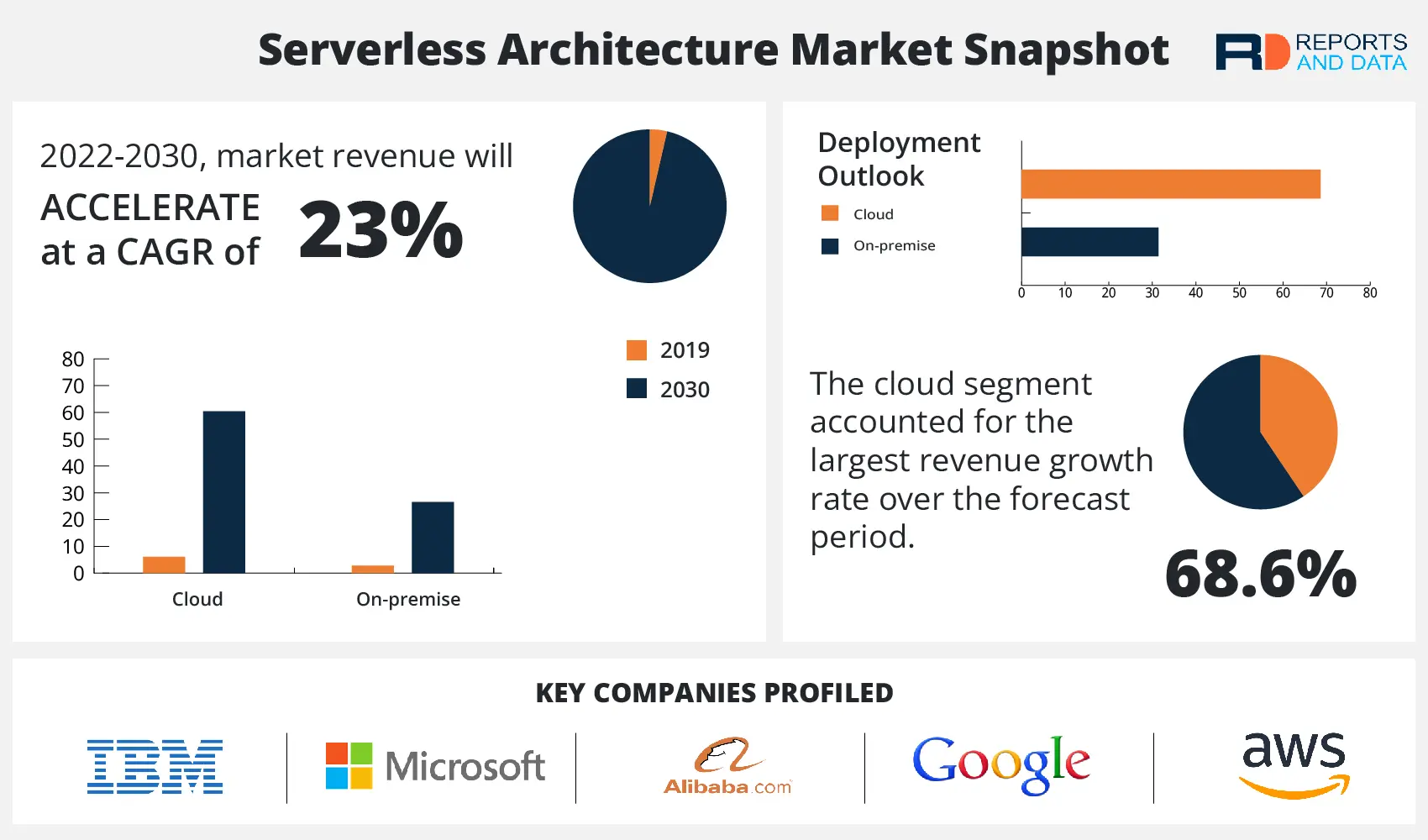🌊 Riding the Wave: What Does a 23.45% CAGR for Serverless Mean for Business? 🌊
As businesses strive to stay ahead of the competition, they are increasingly looking for technology solutions that can save them time and money while offering increased agility. Serverless technology is an attractive option as it enables users to focus on core activities and minimize the costs associated with running traditional IT infrastructure. Serverless with a compound annual growth rate (CAGR) of 23.45% between 2022 and 2030, is rapidly becoming the go-to solution for businesses looking for more efficient ways to manage their IT resources.
- Serverless technology with a CAGR of 23.45% between 2022 and 2030.
- Advantages of serverless technology include reduced costs, scalability, and faster deployment times.
- Companies successfully implementing serverless solutions include Adobe Creative Cloud, Netflix, iRobot, Capital One, Coca-Cola, and The New York Times.
- Alternatives include Infrastructure-as-a-Service (IaaS), Platform-as-a-Service (PaaS), and Software-as-a-Service (SaaS), but they have higher upfront costs and require dedicated teams of engineers and designers to manage.
What is serverless? 💻
Serverless is a cloud computing architecture that allows businesses to access and manage IT resources without having to maintain or provision any physical or virtual servers. It is an increasingly popular solution for many companies seeking more efficient ways to manage their IT resources. The impressive CAGR of 23.45% between 2023 and 2030 further proves that this technology is here to stay.
Why do companies choose serverless solutions? 🏆
There are numerous advantages to using serverless computing that make it an attractive solution for businesses.
The first is cost efficiency. With its “pay-per-use” billing model, companies only pay for the resources they actually use, making it a more economical option than other cloud solutions. It also has lower upfront costs as there is no need to purchase hardware or software licenses. Additionally, since serverless applications can be quickly deployed in most cloud environments without needing to adjust infrastructure or configure servers, companies save time and money on setup and maintenance costs.
Another advantage of serverless is scalability. The cloud automatically provisions and scales resources according to demand, so businesses don’t need to worry about their applications crashing due to high traffic. Plus, they don’t need dedicated teams of engineers to monitor server performance and availability.
Finally, companies benefit from faster deployment times, as they can deploy serverless applications in minutes instead of hours or days. This enables rapid testing and iteration without having to provision hardware or configure servers each time.

Source: Serverless Architecture Market Size, Growth | Forecast 2030 (reportsanddata.com)
How are businesses leveraging serverless technology? 💼
Numerous companies have adopted serverless technology to power their operations, demonstrating its potential for cost efficiency, scalability, and faster deployment times.
- Adobe Creative Cloud uses serverless computing to deliver its products and services to customers quickly and efficiently. They are able to quickly deploy new features and applications in minutes instead of days thanks to the scalability of serverless technology. See more: Adobe + AWS and the Digital Experience Journey | by Ben Tepfer | Adobe Tech Blog
- Netflix also relies on serverless architecture for its streaming services. By leveraging the cost efficiency and scalability of serverless computing, Netflix is able to rapidly scale their resources according to demand without having to provision any physical or virtual servers.
- iRobot is another company that is taking advantage of serverless technology. The company uses it for a range of applications from analytics platforms and data pipelines, to image recognition services. By using serverless, iRobot is able to quickly deploy applications and scale resources according to demand.
- Capital One also relies on serverless technology for its operations. They use it to power their customer-facing applications that require low latency, high throughput, and rapid scalability. More: The serverless-first strategy experience | Capital One
- Coca-Cola has also adopted serverless computing to create a new “smart vending” system powered by artificial intelligence (AI) and machine learning (ML). This enabled them to rapidly develop the platform without having to purchase or maintain any hardware or software licenses. More: Serverless Computing – A Cola Cola Company Case-Study | LinkedIn
- The New York Times uses serverless computing for its content delivery network (CDN). Serverless enables The New York Times’ to quickly deploy content and optimize performance in order to provide a seamless user experience for millions of readers from around the world. See details: New York Times CTO Looks Beyond Cloud to Serverless Computing – WSJ
While computing offers advantages, there are also other alternatives available. Traditional IT solutions such as Infrastructure-as-a-Service (IaaS), Platform-as-a-Service (PaaS), and Software-as-a Service (SaaS) are some of the alternatives.
However, these traditional solutions require more upfront setup costs and a longer time to deploy applications than serverless computing. Plus, they require businesses to maintain dedicated teams of engineers and designers to manage them. This can be expensive in the long run for companies that don’t have large budgets to invest in IT infrastructure.
In comparison, serverless technologies offer a much lower-cost solution that can be deployed quickly and easily. This makes it a great choice for businesses that need to move fast and keep costs low.
Why should businesses invest in serverless technology? 💡
In conclusion, serverless computing is a powerful technology that offers businesses numerous advantages. It provides cost efficiency, scalability and fast deployment times. Companies adopt serverless technology to power their operations – its impressive CAGR of 23.45% between 2022 and 2030 shows clearly that serverless computing is here to stay. Businesses looking to stay competitive in the market should strongly consider investing in this technology.
How to start with Serverless?🚀
Need help with your serverless journey? Our team of experts has extensive experience in serverless architecture and can provide consulting, architecture design, and implementation services to help your business achieve its goals. Do not hesitate to Contact Us.